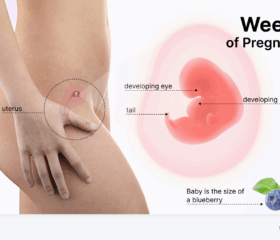Mommy’s Wrist (Mother’s Thumb): Causes, Symptoms, and Treatment
You can finally pick up your adorable little newborn, hold her, and carry her around in your arms. This is an amazing milestone, but unfortunately, it may come with a nagging pain in your wrist and thumb.

When you have a newborn, you’ll constantly be carrying and moving her around. For many moms (and other caregivers), these repetitive and sometimes strenuous motions lead to a form of tendonitis called “mommy’s wrist.”
Let’s take a look at what exactly mommy’s wrist is and how you can find relief from it.
What is mommy's wrist?
De Quervain tenosynovitis, also known as mommy’s wrist, mother’s thumb, or baby wrist, is a condition that affects the two tendons that run along the thumb side of your wrist. 1
When these tendons become irritated or inflamed, they swell, causing pain and discomfort in your wrist, thumb, and hand. 2 3
What does mommy’s wrist feel like?
Mommy’s wrist may feel like a sharp or dull pain that radiates along the thumb side of your wrist or even at the base of your thumb.
You may find that the pain intensifies with heavy lifting, strong gripping, or when you twist your wrist. It can make simple tasks like grabbing, holding, or pinching objects difficult.
Mommy’s wrist might also cause:
- Swelling or redness around your thumb or wrist
- Stiffness and tenderness in your thumb or wrist
- A weakened grip
- A numb thumb and index finger
- Cracking or popping noise as you move your thumb
Serious tendonitis can sometimes lead to a small bump or nodule forming near your thumb. 1 2
Moreover, while postpartum swelling is normal for many moms (including in the wrists), you should let your doctor know if you also have symptoms like blurred vision or shortness of breath. These could be symptoms of postpartum preeclampsia, a dangerous form of high blood pressure that can lead to organ dysfunction.
Is mommy’s wrist the same thing as carpal tunnel syndrome?
Although mommy’s wrist and carpal tunnel syndrome are similar, carpal tunnel pain stems from pressure placed on the nerve that connects the forearm to your palm.
Moreover, carpal tunnel causes tingling, burning, and numbness in the wrist and hand, while mommy’s wrist causes pain when you turn your hand, clench your fist, or hold items.
What exactly causes mommy's wrist?
The main contributing factors to De Quervain tenosynovitis are repetitive movement and overuse of the thumb. As a new mom, you’ll constantly be lifting, holding, changing, repositioning, and carrying your baby, sometimes in awkward and unnatural positions, all of which may contribute to the condition. 2
What factors make mommy’s wrist more likely?
Several factors increase your chances of developing mommy’s wrist. For starters, women in their 40s are more likely to get it than younger moms.
Conditions such as osteoarthritis or rheumatoid arthritis also weaken your joints, making your wrist more prone to injury.
Moreover, you may also be more at risk if you’ve had joint or tendon injuries, with some studies finding that people who’ve had tennis elbow are more likely to develop mommy’s wrist. 3 4
Other caregivers can also experience mommy's wrist
Despite the name, this condition isn’t specific to just moms. While studies do show that women are significantly more likely than men to develop De Quervain tenosynovitis, it’s not impossible to find dads or even other caregivers suffering from the same condition. 3
How to treat mommy's wrist at home
While it’s tricky to avoid the repetitive movements that bring about mommy’s wrist, you can often manage the condition with at-home treatments and lifestyle adjustments. 1 2 3
Rest as much as possible
First off, try to rest your wrist as much as possible. This may feel like an impossible task when you’re a new parent, but do your best to minimize activities that aggravate your pain. If you can’t fully immobilize your wrist and hand, take breaks when doing longer, strenuous tasks.
If you’re struggling to keep your wrist steady, you could also try a wrist and thumb splint for about a week to support your wrist and reduce pain. In addition to wearing it when caring for your baby, you should also wear it when working out or playing sports.
Moreover, don’t be afraid to reach out for help with baby care if you’re struggling with the pain, whether that means leaning on a partner, family member, or friend.
Modify your movements
Pay attention to your body when lifting and carrying your baby or anything heavy. Keep your wrist in a neutral position (as if you’re about to shake someone’s hand) before lifting. Use both hands to carry her and her car seat to distribute the weight evenly.
Instead of pushing your baby in a stroller or carrying her in her car seat, consider using a baby carrier or sling. This distributes her weight more evenly and takes the strain off. If you have to push her in a stroller, try guiding it with your forearms to reduce pressure on your wrists.
Use pillows
When you sit down to breastfeed, bottle-feed, or hold your baby, place a pillow or armrest under your arm and her body. This will give you extra support so that it’s not all on your hands and wrists. If that doesn’t work, switch sides halfway through.
Use ice and heat
Alternate between ice and heat to soothe your soreness and swelling. Apply ice packs (not directly on the skin) for up to 20 minutes at a time, several times a day. Then use heating pads or packs to warm the area.
Use over-the-counter pain relievers
You can use over-the-counter medications like ibuprofen or naproxen to ease your pain and combat inflammation, along with acetaminophen (Tylenol).
However, if you’re breastfeeding, check with your doctor before starting any new medications, including over-the-counter ones. Certain medications, particularly opioids, can get passed to your baby through your breast milk and could have dangerous side effects for her. 5
As a general rule, always get the all-clear from your doctor before trying new medications.
Are there exercises and stretches that help with mommy’s wrist?
In addition to resting your wrist, you can try out a few exercises and stretches to combat mommy’s wrist. Over time, they should help restore your flexibility, strength, and range of motion.
Here are seven exercises to try: 1 2 3
- Wrist flexor stretch: Stretch your arm outwards and flex your wrist upwards with your fingers pointed at the ceiling. Gently bend your hand down to the floor, using your other hand to apply gentle pressure. Stay in this position for 20–30 seconds, then repeat the motion several times.
- Wrist circles: Gently rotate your wrist clockwise for 30 seconds, then roll it counter-clockwise for 30 seconds.
- Thumb stretch: This is also known as the Eichhoff test. Place your arm on a flat surface with your hand and forearm hanging over the edge. With your thumb pointed up to the ceiling, make a fist and tuck your thumb inside it. Gently pull down with your other fingers until you feel a stretching sensation in your thumb. Hold for 20 to 30 seconds and then repeat a few more times. 6
- Passive thumb flexion: Stretch out your arm like you’re about to shake hands. Using your other hand, bend the base of your thumb inward so it’s closer to your palm. Stay put for 15 to 30 seconds, then repeat this up to 3 more times.
- Ball squeezes: Lightly squeeze a stress ball or tennis ball for 5 seconds and then release. Repeat this up to 10 times, several times a day. You can apply more pressure as the pain lessens over time.
- Towel twists: Grip onto a towel with both hands and twist it like you’re wringing out water. Do 3 sets of 10 each way.
How long does mommy's wrist take to heal?
How long it takes for mommy’s wrist to heal depends on how much rest and care you’re able to give it, along with how severe your condition is. That said, if you start treating it early on, your pain may ease up within four to six weeks.
When to see a doctor about mommy’s wrist
While most cases of mommy’s wrist resolve over time, you may need to pay your doctor a visit if your wrist hasn’t improved after 4 weeks of home treatment, or: 3 4
- Your pain is debilitating
- You experience increasing numbness or tingling in your hand or fingers
- Your wrist becomes too stiff to move
- You notice changes in skin color (paleness, blueness, or whiteness)
How doctors treat mommy’s wrist
For severe cases of mommy’s wrist, your doctor may want to proceed with one of the following:
- Corticosteroid injections: Your doctor will inject the corticosteroid into the tendon sheath (the protective covering around your tendons), which will reduce inflammation and provide pain relief. In most cases, you’ll get total relief from the pain with just one or two shots.
- Physical therapy: While you can do many exercises on your own to combat mommy’s wrist, it may also be helpful to work with a physical therapist to learn additional exercises that strengthen your wrist and thumb.
- Surgery: In rare cases, you might need surgery to open up the sheath and relieve pressure.
Up to 80% of patients see their pain ease up with self-treatment or injections, so surgery will be a last resort. 1 3 4
Final thoughts
Looking after a newborn is no easy feat, so adding mommy’s wrist on top can be frustrating, to say the least.
Though you’ll be busy taking care of the newest member of your family, give your wrist and thumb much-needed rest, experiment with at-home remedies, and chat with your doctor if your pain doesn’t ease up.
Never be afraid to ask your friends and family for a little help with your newborn. As the old adage goes, it takes a village to raise a child!
Article Sources
- MedlinePlus. "De Quervain tendinitis" Retrieved September 24, 2025.
- U.S. Department of Veterans Affairs. "Understanding De Quervain Tenosynovitis" Retrieved September 24, 2025.
- StatPearls. "De Quervain Tenosynovitis" Retrieved September 24, 2025.
- OrthoInfo. "De Quervain's Tenosynovitis" Retrieved September 24, 2025.
- American Family Physician. "Medication Safety in Breastfeeding" Retrieved September 24, 2025.
- Physiopedia. "Finkelstein Test" Retrieved September 24, 2025.







